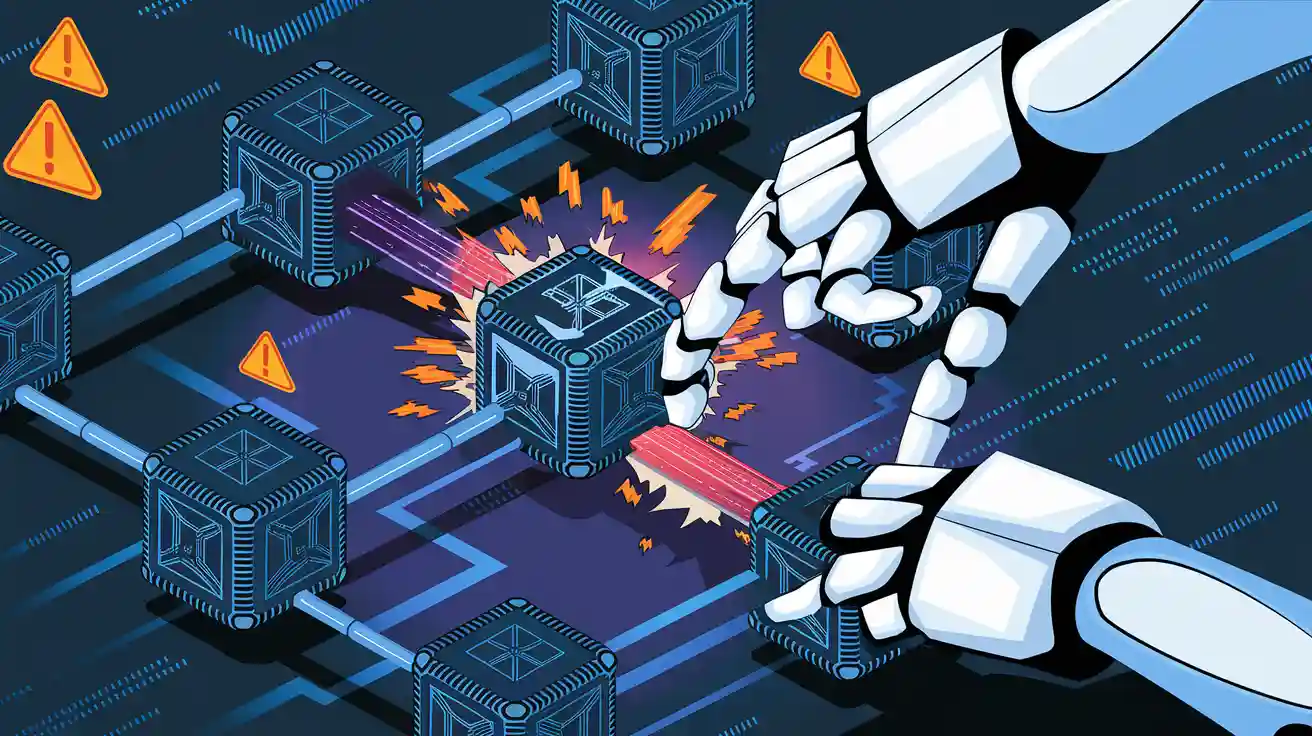What Would Happen if Someone Attempted to Change the Blockchain Ledger System?
2025-05-02 09:03:53
Blockchain systems maintain an immutable ledger, ensuring data integrity through cryptographic hashing and decentralized validation. However, one might wonder, what would happen if someone attempted to change the blockchain ledger system? Any tampering attempt triggers immediate detection and rejection by the network. Studies reveal vulnerabilities like 51% attacks and external data dependencies, but blockchain technology remains a reliable system, offering unparalleled security and trust across decentralized networks.
How Blockchain Ensures an Immutable Ledger

Blockchain systems rely on several mechanisms to ensure their ledgers remain immutable. These mechanisms include cryptographic hashing, consensus protocols, and decentralization. Together, they create a robust framework that protects blockchain networks from tampering and ensures data integrity.
Cryptographic Hashing and Data Integrity
Cryptographic hashing plays a critical role in maintaining the integrity of blockchain data. A hash function converts input data into a fixed-length string of characters, known as a hash. Even the slightest change in the input data results in a completely different hash, making tampering easily detectable.
Hash functions act as sentinels, safeguarding data from unauthorized modifications. Even slight alterations in the data will produce a different hash, alerting you to a potential security breach.
For example, blockchain systems use hashing algorithms like SHA-256 to secure their data. This algorithm provides robust protection against data integrity threats, making it a preferred choice for blockchain technology. Additionally, immutable data structures like Merkle trees summarize transactions into a root hash. This allows blockchain networks to verify data integrity quickly and efficiently.
Consensus Mechanisms and Decentralized Validation
Consensus mechanisms ensure that all participants in a decentralized ledger system agree on the validity of transactions. These mechanisms prevent unauthorized changes to the blockchain by requiring agreement among nodes before adding new blocks.
The process typically involves several steps:
- A participant submits a transaction request, which is broadcast to all nodes in the network.
- Nodes validate the transaction based on predefined rules.
- Validated transactions are grouped into a block and proposed to the network.
- Nodes participate in the consensus process to accept the proposed block.
- Once consensus is reached, the block is added to the blockchain.
Proof of Work (PoW) and Proof of Stake (PoS) are two widely used consensus mechanisms. PoW requires miners to solve complex puzzles, making tampering computationally expensive. PoS, on the other hand, allows validators to stake cryptocurrency to validate transactions, reducing energy consumption while enhancing blockchain security best practices.
The Role of Decentralization in Preventing Tampering
Decentralization is a cornerstone of blockchain technology. Unlike traditional systems, where a central authority controls data, blockchain networks distribute data across multiple nodes. This decentralized structure makes it nearly impossible for a single entity to alter the blockchain.
Case studies highlight the effectiveness of decentralization in preventing tampering:
| Case Study | Description |
|---|---|
| Blockchain in Cybersecurity | Demonstrates a decentralized and tamper-evident approach to data protection. |
| West Virginia Voting Pilot | Improved trust and eliminated vote tampering concerns for military personnel. |
| Republic of Georgia Land Registry | Enhanced transparency and security in property transactions. |
By distributing data across a decentralized network, blockchain systems ensure financial data integrity and protect against cyber threats. This structure not only enhances trust but also provides a reliable audit trail for sensitive information.
What Would Happen if Someone Attempted to Change the Blockchain Ledger System?
Immediate Detection and Rejection by the Network
Blockchain networks are designed to detect and reject any unauthorized changes to their ledger almost instantly. This process relies on a series of technical checks performed by nodes across the decentralized system. Each node validates the integrity of the data before accepting it as part of the blockchain.
The detection process involves multiple steps:
| Step | Description |
|---|---|
| 1 | Node Address Verification: Checks if the node's address matches the first vetter's address. |
| 2 | Transaction Verification: Validates each transaction's signature and overall validity. |
| 3 | Forger and Vetter Verification: Ensures the forger and second vetter are correct. |
| 4 | Block Consistency Check: Compares the current block's previous hash and index with the last block. |
| 5 | Transaction Fee Calculation: Compares total transaction fees with the block's fees. |
| 6 | Merkle Tree Validation: Constructs and compares the Merkle tree of transactions. |
| 7 | Successful Vetting: Returns true if all checks pass. |
These steps ensure that any attempt to alter the blockchain ledger system is immediately flagged and rejected. For example, if someone tries to modify a transaction, the Merkle tree validation would fail, and the network would reject the block containing the altered data. This robust vetting process highlights the strength of blockchain security issues in maintaining data integrity.
Security Breaches and Loss of Trust
Tampering with the blockchain ledger system could lead to significant security breaches. If an attacker successfully bypasses the detection mechanisms, the consequences could be catastrophic. Blockchain transactions rely on trust, and any compromise in security undermines this foundation.
A breach could expose sensitive financial data or disrupt critical operations. For instance, in a blockchain-based voting system, tampering could invalidate election results, eroding public trust in the technology. Similarly, in supply chain management, altered data could lead to counterfeit goods entering the market, damaging brand reputation and consumer confidence.
Trust is the cornerstone of blockchain technology. Any breach not only impacts the immediate users but also casts doubt on the system's reliability for future applications.
The impact of blockchain security issues extends beyond technical failures. Loss of trust in the system could deter adoption, stalling innovation and economic growth in industries that depend on blockchain.
Systemic Failures and Economic Impacts
Attempts to alter the blockchain ledger system could trigger systemic failures across interconnected networks. Blockchain operates as a decentralized ecosystem, meaning disruptions in one part of the system can ripple through others. For example, tampering with a financial blockchain could affect payment processing, lending platforms, and even global trade.
Economic impacts of such failures could be severe. Businesses relying on blockchain for secure transactions might face financial losses due to compromised data. Governments using blockchain for public services could experience operational delays, affecting citizens and public trust. Additionally, the cost of recovering from such failures—both in terms of time and resources—could be substantial.
The broader impact of blockchain tampering highlights the importance of maintaining its integrity. Blockchain security issues must be addressed proactively to prevent systemic failures and protect the economic stability of industries that depend on this technology.
The Feasibility of Altering Blockchain Systems

Overcoming Decentralized Consensus: Challenges and Impossibilities
Decentralized consensus is the backbone of blockchain technology. It ensures that no single entity can control or manipulate the system. However, overcoming this consensus presents significant challenges. The scalability trilemma, introduced by Vitalik Buterin, highlights the trade-offs between decentralization, security, and scalability. Decentralization fosters trust by distributing control across multiple nodes. Yet, it slows transaction processing because every node must validate each transaction. Security mechanisms like Proof of Work (PoW) enhance integrity but further reduce scalability. These challenges of blockchain immutability make altering the system nearly impossible without disrupting its core principles.
51% Attacks: How They Work and Why They’re Rare
A 51 percent attack occurs when an entity gains control of more than half of a blockchain network's computational power. This control allows the attacker to reverse transactions, enabling double spending. Smaller or newer cryptocurrencies are more vulnerable to such attacks due to their limited network size. For instance:
| Mechanic | Description |
|---|---|
| Control of Network Power | An entity controlling over 50% of the network's computational power can manipulate transactions. |
| Double Spending | This control allows for the possibility of reversing transactions or spending the same currency twice. |
| Network Size Mitigation | Increasing the size of the network can help mitigate the risk of such attacks. |
| Consensus Mechanisms | Using consensus mechanisms that resist centralization can also reduce vulnerability to attacks. |
Despite these risks, 51 percent attacks remain rare. Large blockchain networks like Bitcoin require immense computational power, making such attacks economically unfeasible.
Cryptographic Security and Computational Barriers
Blockchain relies on cryptographic algorithms to secure its data. SHA-256, used in Bitcoin, ensures data integrity by making it computationally infeasible to alter past transactions. However, advancements in quantum computing pose potential risks. Algorithms like Shor's could break elliptic curve cryptography, which many blockchains use for key generation.
| Finding | Description |
|---|---|
| Quantum Threat | Quantum computing poses a significant risk to Bitcoin's cryptographic security. |
| SHA-256 Vulnerability | While SHA-256 is secure against classical attacks, quantum algorithms could reduce the time needed to break it. |
| ECC Risk | Shor's algorithm could efficiently break elliptic curve cryptography. |
| Proactive Measures | Developing quantum-resistant cryptographic methods is essential for future security. |
To address these challenges, the blockchain community must adopt quantum-resistant algorithms. This proactive approach will ensure the continued security of blockchain in accounting and other industries.
Blockchain serves as an immutable ledger, ensuring trust and transparency in distributed systems. Once data enters a block, altering it becomes nearly impossible. Cryptographic hash functions secure transactions, creating immutable records that enhance reliability. The benefits of immutability extend to decentralized networks, where tamper-proof chains uphold trust and integrity. Blockchain’s future depends on preserving these principles.
FAQ
What makes blockchain immutable?
Blockchain achieves immutability through cryptographic hashing and decentralized consensus. These mechanisms ensure that altering data becomes computationally infeasible, preserving the integrity of the ledger.
Can someone hack a blockchain system?
Hacking a blockchain is extremely difficult due to its decentralized structure and cryptographic security. However, smaller networks may face risks like 51% attacks, which remain rare.
How does blockchain impact industries?
Blockchain enhances transparency, security, and efficiency across industries like finance, healthcare, and supply chain management. Its decentralized nature ensures trust and reduces operational risks.